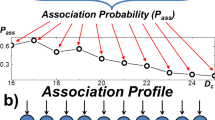Abstract
A challenge in systems biology is to discover new functional associations between proteins and, from these new relationships, assign functions to unannotated proteins. High-throughput data can be the key to achieve this task, but they often lack the degree of specificity needed for predicting accurate protein functional associations. This improvement in specificity can be achieved through the integration of heterogeneous data sets in a suitable manner. In this paper, we assess the quality of prediction of functional associations between proteins in two cases: (1) using each data source in isolation and (2) by means of Artificial Neural Networks through the integration of different biological data sources.
Access this chapter
Tax calculation will be finalised at checkout
Purchases are for personal use only
Preview
Unable to display preview. Download preview PDF.
Similar content being viewed by others
References
Linghu, B., et al.: Genome-wide prioritization of disease genes and identification of disease-disease associations from an integrated human functional linkage network. Genome Biology 10 (2009)
Linghu, B., et al.: High-precision high-coverage functional inference from integrated data sources. BMC Bioinformatics 9 (2008)
Bradford, J.R., et al.: GO-At: in silico prediction of gene function in Arabidopsis thaliana by combining heterogeneous data. The Plant Journal 61, 713–721 (2010)
Lee, I., et al.: A probabilistic functional network of yeast genes. Science 306, 1555–1558 (2004)
Wu, C.C., et al.: Predicting of human functional genetic networks from heterogeneous data using RVM-based ensemble learning. Bioinformatics 26, 807–813 (2010)
Myers, C.L., et al.: Finding function: evaluation methods for functional genomic data. BMC Genomics 7 (2006)
Feng, L.H., et al.: Classification error of multilayer perceptron neural networks. Neural Computing & Applications 18, 377–380 (2009)
Zhou, Z., et al.: Training Cost-Sensitive NNs with Methods Addressing the Class Imbalance Problem. IEEE Trans. on Knowledge and Data Eng. 18, 63–77 (2006)
The Reference Sequence Collection, http://www.ncbi.nlm.nih.gov/projects/RefSeq/
Kanehisa, M., Goto, S., et al.: The KEGG resource for deciphering the genome. Nucleic Acids Res. 32, D277–D280 (2004)
von Mering, C., et al.: STRING 8–a global view on proteins and their functional interactions in 630 organisms. Nucleic Acids Res. 37 (2009)
Breitkreutz, B.J., et al.: The BioGRID Interaction Database: 2008 update. Nucleic Acids Res. 36, 637–640 (2008)
Ashburner, M., et al.: Gene ontology: tool for the unification of biology. The Gene Ontology Consortium. Nat.Genetc. 25, 25–29 (2000)
Saccharomyces Genome Database, http://www.yeastgenome.org/
He, H., et al.: Learning from Imbalanced Data. IEEE Trans on Knowledge and Data Eng. 21, 1263–1284 (2009)
Author information
Authors and Affiliations
Editor information
Editors and Affiliations
Rights and permissions
Copyright information
© 2011 Springer-Verlag Berlin Heidelberg
About this paper
Cite this paper
Florido, J.P., Pomares, H., Rojas, I., Urquiza, J.M., Ortuño, F. (2011). Prediction of Functional Associations between Proteins by Means of a Cost-Sensitive Artificial Neural Network. In: Cabestany, J., Rojas, I., Joya, G. (eds) Advances in Computational Intelligence. IWANN 2011. Lecture Notes in Computer Science, vol 6692. Springer, Berlin, Heidelberg. https://doi.org/10.1007/978-3-642-21498-1_25
Download citation
DOI: https://doi.org/10.1007/978-3-642-21498-1_25
Publisher Name: Springer, Berlin, Heidelberg
Print ISBN: 978-3-642-21497-4
Online ISBN: 978-3-642-21498-1
eBook Packages: Computer ScienceComputer Science (R0)




